|
PERU - DAY FOUR - Lake Titicaca |
|
Previous Blogs:
Day 1 - Arequepa | Day 2 -
Yanque | Day 3 - Colca Canyon |
Day 4 - Lake Titicaca |
Day 5 - Road to Cusco | Day 6 - Machu Picchu
| Day 7 - Cusco
Day 8 - Sacred Valley |
Day 9
- Salt and Terraces | Day 10 - Rain Forrest
| Day 11-12 - Rainforest/Lima |
Day 13 - Paracus
Click photos for a larger image... |
|
While we have heard several other travelers woe of Altitude
Sickness, we have not had too much of a rough time. Sure the 16,000
foot day kicked our asses with a little dizziness, but since then we
constantly been between 10,000 and 13,000. The only real issue
is each morning we wake up with blurry vision, like someone changed
the prescription in our glasses. We are only able to see long
distance through reading glasses. This fades away after a couple
hours. Shortness of breath when hiking uphill is the only other
symptom I have experienced. Wendy experienced mild low grade
headaches for a very short amount of time. A few aspirin and she was
better in no time. And they say no drinking or smoking at high
altitudes - hell, that's what's keeping us going! |
|
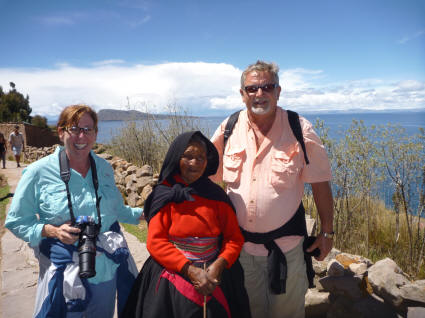 |
We are in Puno, a
city of 250,000 located on Lake Titicaca which sits at 12,500 feet
above sea level; thus making this the highest navigable lake in the
world. To pronounce Titicaca the correct way...
tit -
tee - KA - KA
If you don't
emphasize the KA-KA emphatically enough, they frown at you.
The lake borders on
two countries Peru and Bolivia. 5 major rivers feed into the lake
and 22 smaller ones. The lake temperature is pretty much the same
year round, about 52 degrees.
We were picked up at
6.45am for a short bus ride to the port. Our agent, after hearing us
"complain" about really long days, made a few calls and got us on a
much faster boat, cutting our 10 hour tour down to less than eight
hours. We were very happy with this. |
|
Unfortunately when morning dawned it was raining, so we had
to buy rain coats ($1.70 each). That broke the bank.
We began with a 40 minute boat ride to a "floating island".
If the agent had not gotten us on a different boat, that 40
minute ride would have been 1.5 hours. |
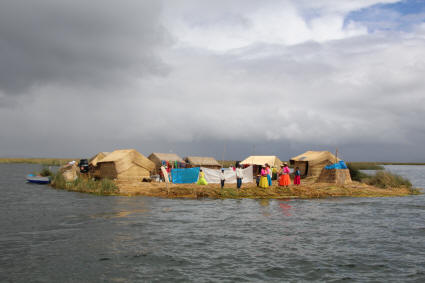
These island are made out of reeds and takes 6 months to a
year to make one. They are then anchored at a favorite
spot and several families live on it permanently. |

This has been a practice for hundreds of years and it is
believed these people escaped to the water to get away from
the Spanish conquerors. |
|
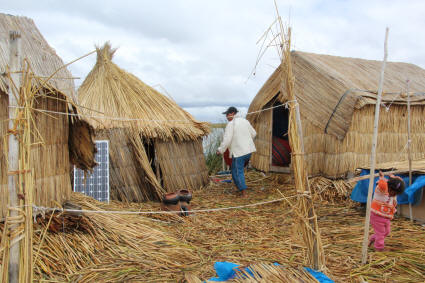
Everything is made from reeds
from the floors to the houses - which are single room
occupied by an entire family. |

Here they are harvesting reeds to maintain their homes. The
islands and houses last for up to 20 years before they have
to be rebuilt. |
 |
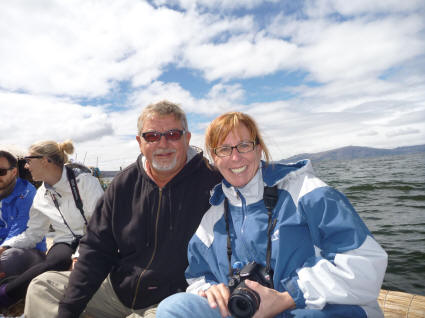 |
|
Finally the sun came out and it turned into a beautiful day!
For $3 a head, they took us on a 20 minute ride on their
home made reed boats which are surprisingly stable and
comfortable. They have other boats with outboards to get to
the mainland for supplies and trading, the reed boats are
used locally around their house for fishing and are driven
by poles. |
|
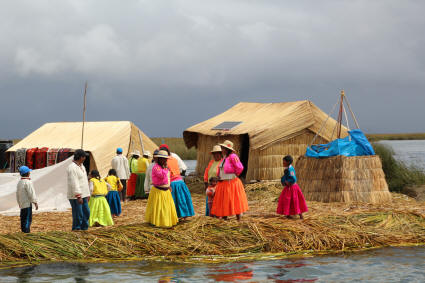
They are Catholic but speak
their own language which isn't Spanish, and also incorporate
a "Mother Earth" paganistic twist to their religion with the
many festivals throughout the year. |

They even have a pet kitty cat! |
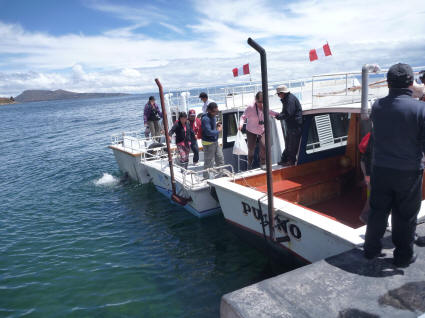 |
We then left for our next stop, the island of Taquile.
There are 2200 people that live on this island. As you can
see docking is done on first come first served basis and
everyone else rafts up.
There are no cars, no hotels only a few stores selling basic
goods and then many restaurants that cater to the visiting
tourists.
The Taquileños run their society based on community
collectivism and on the Inca moral code: do not steal, do
not lie, do not be lazy. The island is divided into six
sectors for crop rotation purposes, and sheep farming.
The economy is based on fishing, terraced farming of
potatoes, and tourist-generated income from the
approximately 40,000 tourists who visit each year. |
|
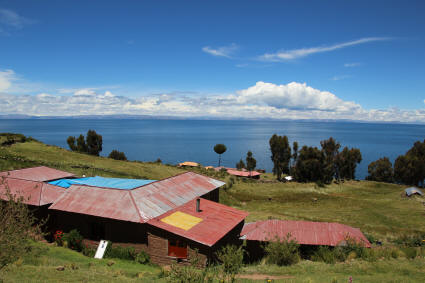
Directly opposite shore is
Bolivia. |
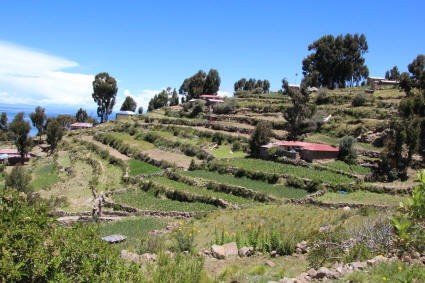
Terraced farming. |
|
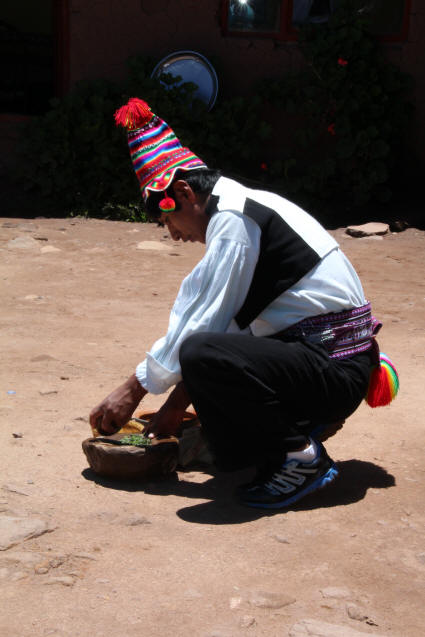 |
 |
|
We were treated to a cultural display and
then served lunch which was locally caught trout and very
delicious. They have an interesting culture - the men knit
and make the women's clothes and if they want to marry the
couple has to live together for three years to see if it
will work before they can get married (with a chaperone, of
course).
Once married, the new bride cuts her hair
and braids it into the multicolored tapestry belt for her
new husband (Above left he is wearing it). Women also
wear black "cloaks" (Above Right) which resemble the habit
of a nun, which the husband knits for her. |
|
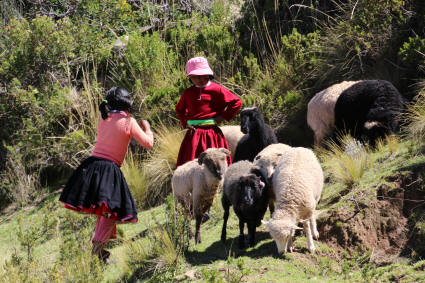
Even in the field they wear
traditional dress |
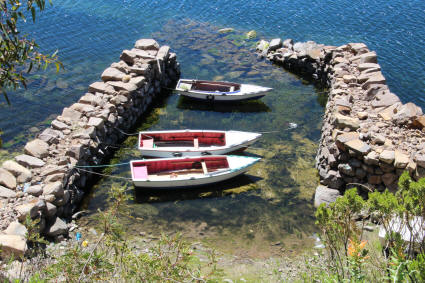
Safe harbors built for their
boats |
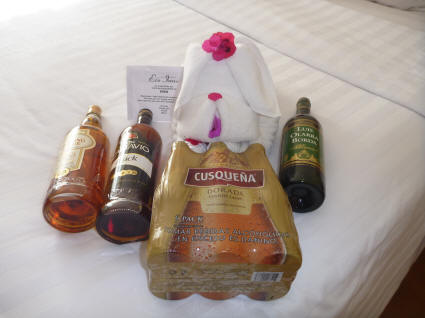 |
Once we got back we asked our driver if he could stop off at
a liquor store on the way back to replenish our supplies.
Pictured on the left (together with the pretty animal our
hotel had made from towels) is our haul.
1 liter scotch, 1 liter Rum, a bottle of wine and a six
pack of beer. Cost? $31.00 - less than half you would pay in
the USA for the same items!
|
|
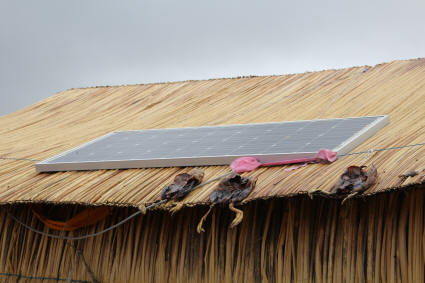 |
And finally... If you live on a reed island with no
electricity, why not invest in a solar panel and stick it up
on your roof next to the ducks you are drying out?
Duck Jerky! |
|
